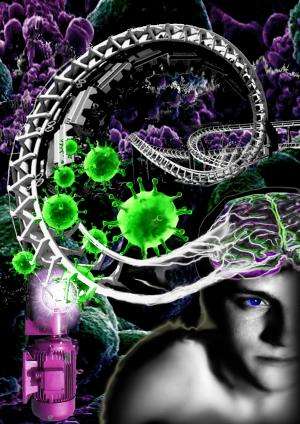Gene therapy using lentivirus promising in three youngsters

Two Houston researchers from Baylor College of Medicine and Texas Children's Hospital were part of an international team that developed a new gene therapy approach to treatment of Wiskott-Aldrich Syndrome, a fatal inherited form of immunodeficiency.
The new research, led by researchers at the San Raffaele Telethon Institute for Gene Therapy in Milan, Italy was published in Science Express.
The disorder that weakens the body's immune system is caused by a mutation in a gene that encodes the protein WASP. The most often used therapy is a bone marrow or stem cell transplant from a matching donor—often a sibling or relative. It can be curative for some patients – mostly those who have a strongly matching donor.
An alternative is to obtain blood stem cells from patient, and, in the laboratory, use gene therapy involving a form of retrovirus to take the normal gene into the cells to correct the defect. The patients are then given back the genetically changed blood cells back.
This approach has been successful in a number of diseases, including who had Wiskott-Aldrich Syndrome. However, over the long term, some patients with immune deficiencies, including those with Wiskott-Aldrich Syndrome, developed blood cancers.
Researchers believe the viral vector used to take the gene into the cell inserted itself next to a oncogene in the DNA, turning it on and causing the cancers.
In this new research, the team used a partially inactivated lentivirus to take the normal gene into the cell, while reducing the risk of the gene inserting next to a cancer-promoting gene.
In these cases for whom there was no matching donor, the researchers led by Alessandro Aiuti of San Raffaele Telethon Institute for Gene Therapy in Milan, Italy; and including Dr. Jordan Orange, professor of pediatrics—rheumatology and Pinaki Banerjee, assistant professor of pediatrics – human immunology at BCM and Texas Children's, took the patients' own blood stem cells and, in the laboratory, used the lentiviral vector combined with the normal WASP gene to correct the genetic defect in the blood. After a special treatment to eliminate their defective immune system, they received their own blood cells that had been altered to contain the normal WASP gene.
After 20 to 30 months, the three children showed significant improvement. New blood cells had the corrected WASP gene.
Orange referred one of the patients for treatment and saw one of them at a recent meeting. He and Banerjee contributed to the analysis of the gene corrected patient cells at the laboratory level using highly quantitative high-resolution imaging Orange maintains a high-and super resolution imaging facility in the Center for Human Immunobiology at Texas Children's Hospital.
More information: "Lentiviral Hematopoietic Stem Cell Gene Therapy Benefits Metachromatic Leukodystrophy," by A. Biffi et al Science Express, 2013.














